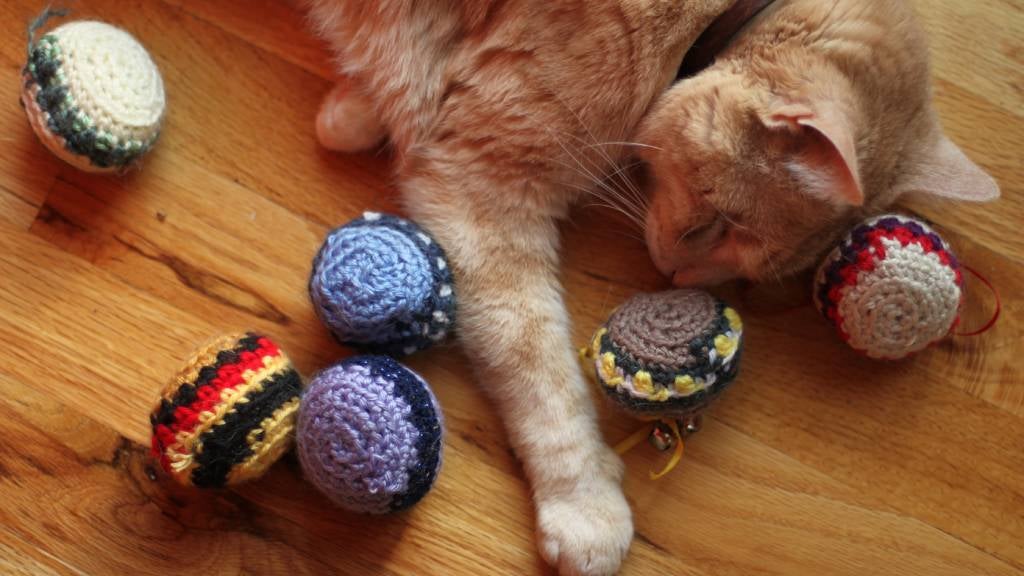Keep your pet purring with DIY cat toy ideas

DIY cat toys are a choice way to keep your pet physically active and mentally stimulated. Not only do homemade toys provide endless hours of fun, but they’re also an affordable option that can easily be crafted with everyday items with a bit of do-it-yourself kiwi ingenuity.
As our friend CANZ Accredited Animal Behaviour Consultant, Mat Ward (BSc MVS CCAB) highlights, predatory behaviour isn’t just a playful pastime; it’s an instinctual need. "Even the cuddliest lap cat has a hunter lurking within," Mat says.
Cats, wired to hunt for survival, have been doing so for over a million years. So, it’s essential to provide an outlet for them to tap into these instincts, especially for indoor cats who may otherwise lack opportunities to chase, pounce, stalk, and hunt.
Why DIY cat toys are great for your feline friend
As natural hunters, cats love the thrill of the chase. DIY toys for cats, made with simple materials, are an ideal way to offer this enrichment safely. One key advantage of DIY toys and furniture over store-bought gadgets (which can also be lots of fun!) is their ability to be custom-crafted for your specific cat, matching your cat’s playing preferences, offering them all the things they love, without the things they don’t.
"With DIY toys, you can precisely tailor them to your cat's preferences and the types of 'prey' they find most stimulating," Mat Ward explains.
You can adjust size, texture (e.g. using feathers to mimic birds or soft fabrics for small mammal-like toys), and movement to match what triggers your cat's hunting interest.
Not only do they cater to your cat’s instincts, but they also offer sustained engagement, Mat emphasises. Unlike store-bought toys that can lose their novelty quickly, DIY toys can be easily modified or refreshed, keeping your cat’s "hunting ground" dynamic and stimulating. "Homemade toys allow for constant, inexpensive iteration and variation," Mat says.
The best parts? They’re cost-effective, allowing you to create multiple toys without breaking the bank, and they can be a fun activity for the whole family.
Easy materials you'll need for homemade cat toys
Keeping your cat enriched doesn’t have to be expensive or complicated. Many materials you can use are likely already lying around your home. Here are some easy-to-find items you can repurpose into fun, engaging toys for your cat:
- Cardboard: Perfect for building scratching posts, tunnels, or even small playhouses. You can even repurpose the piles of toilet rolls stacking up beside the loo.
- Feathers: Great for mimicking the flight of birds, triggering your cat’s hunting instincts.
- Sisal rope: This material, or similar, is perfect for creating durable scratching posts or toys that require a bit more texture.
- Fabric scraps: Soft and safe materials for making plush toys or snuffle mats.
How to make a feather fascinator toy
Mat suggests that interactive feathers toys are essential for satisfying your cat’s natural predatory drive. “The unpredictable flight of the feathers mimics the movement of prey and stimulates the hunting instinct, which is key to their physical and mental wellbeing.”
Materials Required:
- Sturdy stick or dowel
- Strong cord
- Feathers
Step-by-Step:
- Securely attach the cord to the stick.
- Tie or glue the feathers to the end of the cord.
- Vary the movement of the toy, giving your cat a chance to "catch" the feathers periodically to avoid frustration.
Mat's tip: Running the toy over bumpy surfaces like cushions can further trigger the hunting drive.
Building a cardboard cat skyscraper
Cats love to climb and perch, so a DIY cardboard cat toy skyscraper can provide both mental and physical stimulation. This DIY toy can help satisfy both climbing and scratching instincts.
Materials required:
- Several sturdy cardboard boxes
- Scissors
- Tape
Step-by-Step:
- Cut the boxes into different shapes and sizes.
- Stack the boxes to create a multi-level tower, and reinforce and attach to each other with tape.
- Add small ramps or windows to make the structure more interesting for your cat.
Mat's tip: Climbing structures provide both physical exercise and mental stimulation. Giving your cat a multi-level space to explore satisfies both their need for climbing and their instinct to hunt.
Creating simple DIY cat puzzle toys
“Puzzle toys are excellent for engaging a cat’s mind and keeping them entertained. These types of toys mimic the hunting process by rewarding them with intermittent food, which satisfies their natural drive to hunt.” Mat says.
Materials required:
- Plastic egg
- Treats
- Small hole punch
Step-by-Step:
- Make a small hole in the plastic egg, large enough to allow dry treats to pass through.
- Fill the egg with treats.
- Let your cat bat it around to release the treats.
Mat's tip: Start with a larger hole for easy access, then gradually reduce the size as your cat becomes more skilled at using the puzzle. You can use tape to reduce the size or add bigger treats, or you may want to make a new one with smaller holes as your cat gets more skilled.
DIY solutions for crafty cat parents
Making DIY cat toys is a top way to keep your kitty entertained, exercised, and happy, without emptying your wallet at the pet shop. By using simple things you probably already have lying around, you can craft perfect toys for your pet.
Whether it’s a feather toy to trigger their hunting drive or a cardboard tower for some serious climbing fun, these toys are great for keeping your feline mate engaged. Plus, as Mat Ward tells us, satisfying their predatory instincts is key to their overall well-being – it’s a win all around!
Ready to safeguard your cat’s health with cat insurance? Get peace of mind with SPCA Pet Insurance. Consider getting a quote today and know they’re covered for life’s little surprises.
12 Aug 2025
